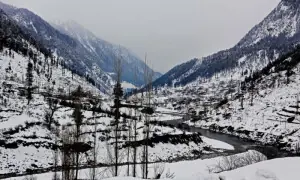Energy saving backfired? What caused Pakistan’s power breakdown
The major power breakdown in Pakistan — the second within the past three months — was caused by a move to cut on energy costs and to overcome fuel shortage, sources in the Power Division told journalists.
More than 12 power plants that include Guddu, Jamshoro, and Muzaffargarh were not working on Monday morning, causing the massive breakdown.
Shocking as it may seem, the power plants in Bhikki, Haveli Bahadur Shah, and Nandipur were out of fuel, the sources told Aaj News.
It was revealed that 969MW of the Neelum Jhelum project is closed for the past eight months and the production of electricity from the Quadi-e-Azam Solar Plant is near to none.
The closure of Neelum Jhelum and the solar power plant, however, did not cause much of a problem as power consumption falls in winter across the country.
But an additional measure did.
Power Division officials told reporters that power plants in the country are shut down overnight during low usage hours. On Monday, technicians could not boot up the system again and it sparked the breakdown.
Energy Minister Khurram Dastagir also confirmed that the practice of shutting down plants at night existed.
“Just because the electricity demand is less during winters, most of the systems are shut down at night and the next morning they are opened one by one,” he told the news agency Reuters.
“At the time of power generation, each megawatt is looked at to see what effect it will have on the power tariff, and in winter, as the demand for power is less, the system is mostly shut down at night and the system is turned on again one by one in the morning,” he said.
Dastagir and his ministry said that the power breakdown was caused after the system frequency of the national grid went down at 7:34am Monday morning.
Sources said that the production of electricity was less than 7,000MW and the shortfall was recorded at 6,000MW. A 90% shortage was recorded in hydroelectricity production, they added.
Pakistan’s electricity generation capacity reached 41,557 megawatts in July-April 2021-22, after an 11.5% increase, according to the Economic Survey of Pakistan 2021-22.
The National Electric Power Regulatory Authority (NEPRA) has taken notice of the blackout and sought a report from the National Transmission and Despatch Company.
For years, Pakistan is trying to boost its energy sector and mitigate power blackouts that plagued the country over the past decade. It did manage to increase power generation in 2013. But, it is still struggling due to high fuel costs in the face of the Ukraine war, dependence on imported energy products, depleting gas reserves, debt in the power sector, and old transmission and distribution systems.
“Weak governance, uncoordinated energy policymaking, and a lack of long-term energy planning have also added to Pakistan’s energy woes,” says the International Trade Administration in its review of the country.
Pakistan receives the bulk of its crude oil (energy imports) from the Gulf. It is now pursuing cheaper options in the face of sanctions on Russia after the Ukraine war. Both countries have agreed to sort out all the entanglements – transportation, insurance, payment, and rolling – for a supply of crude oil by late March.
Kremlin is not the only cheaper avenue of energy Pakistan is looking in the face of high import bills. The country is working with Azerbaijan, Turkmenistan, and Iran to come out of the energy crunch situation.
What is the share of Pakistan’s energy sources
Below is the data on the share of Pakistan’s energy sources:
| Share | Dec-22 |
|---|---|
| Nuclear | 27.1% |
| Hydel | 20.4% |
| Coal | 18.1% |
| Gas | 15.1% |
| RLNG | 13.7% |
| Wind | 2.5% |
| Baggasse | 1.2% |
| Solar | 0.8% |
| RFO | 0.5% |
| HSD | 0.0% |
| Others | 0.5% |
| Total | 100% |
With additional input from news agencies
For the latest news, follow us on Twitter @Aaj_Urdu. We are also on Facebook, Instagram and YouTube.

















Comments are closed on this story.